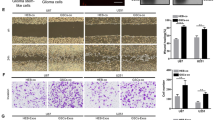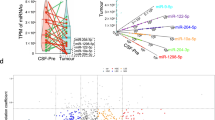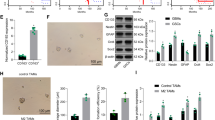Abstract
It is well established that human marrow stromal cells (hMSCs) can directly migrate towards tumor microenvironments associated with tumor formation and intracellular communication. Gene regulatory networks in tumors may be targeted by microRNAs (miRNAs), especially those derived in exosomes from hMSCs. However, the potential functional roles of hMSCs in glioma cell growth still remain controversial. Therefore, this study aimed at exploring the regulatory mechanisms of hMSC exosomal microRNA-375 (miR-375) in glioma. Microarray analysis was used to initially screen out glioma-related genes. The interaction between miR-375 and solute carrier family 31 member 1 (SLC31A1) was confirmed by dual-luciferase reporter gene assay. miR-375 and SLC31A1 expression in glioma cells were determined. Glioma cells were initially exposed to exosomes derived from hMSCs treated with miR-375. Subsequently, the rates of proliferation, migration, invasion and apoptosis were determined in glioma cells using in vitro assays. The effects of exosomal miR-375 from hMSCs on tumor growth in vivo were also measured using xenograft tumor in nude mice. We found that miR-375 and SLC31A1 showed significantly lower and higher expression of glioma cells respectively. Additionally, restored miR-375 expression resulted in suppressed cell proliferation, migration and invasion, and increased apoptosis by targeting SLC31A1. Next, in vitro experiments demonstrated that hMSC-derived exosomes overexpressing miR-375 promoted apoptosis while suppressing proliferation, migration and invasion. Furthermore, in vivo experiments confirmed the negative regulatory effects of hMSC-derived exosomes with overexpressed miR-375. We conclude that exosomal miR-375 from hMSCs inhibits glioma cell progression through SLC31A1 suppression, and ultimately serves as a potential target in the treatment of gliomas.
This is a preview of subscription content, access via your institution
Access options
Subscribe to this journal
Receive 12 print issues and online access
$259.00 per year
only $21.58 per issue
Buy this article
- Purchase on Springer Link
- Instant access to full article PDF
Prices may be subject to local taxes which are calculated during checkout









Similar content being viewed by others
References
Wang Y, Sui X, Zhao H, Cong L, Li Y, Xin T, et al. Decreased circular RNA hsa_circ_0001649 predicts unfavorable prognosis in glioma and exerts oncogenic properties in vitro and in vivo. Gene. 2018;676:117–22.
Yang L, Song X, Gong T, Jiang K, Hou Y, Chen T, et al. Development a hyaluronic acid ion-pairing liposomal nanoparticle for enhancing anti-glioma efficacy by modulating glioma microenvironment. Drug Deliv. 2018;25:388–97.
Trento C, Marigo I, Pievani A, Galleu A, Dolcetti L, Wang CY, et al. Bone marrow mesenchymal stromal cells induce nitric oxide synthase-dependent differentiation of CD11b(+) cells that expedite hematopoietic recovery. Haematologica. 2017;102:818–25.
Thej C, Ramadasse B, Walvekar A, Majumdar AS, Balasubramanian S. Development of a surrogate potency assay to determine the angiogenic activity of Stempeucel(R), a pooled, ex-vivo expanded, allogeneic human bone marrow mesenchymal stromal cell product. Stem Cell Res Ther. 2017;8:47.
Ma JC, Cheng P, Hu Y, Xue YX, Liu YH. Integrin alpha4 is involved in the regulation of glioma-induced motility of bone marrow mesenchymal stem cells. Oncol Rep. 2015;34:779–86.
Viola S, Traer E, Huan J, Hornick NI, Tyner JW, Agarwal A, et al. Alterations in acute myeloid leukaemia bone marrow stromal cell exosome content coincide with gains in tyrosine kinase inhibitor resistance. Br J Haematol. 2016;172:983–6.
Wen D, Peng Y, Liu D, Weizmann Y, Mahato RI. Mesenchymal stem cell and derived exosome as small RNA carrier and immunomodulator to improve islet transplantation. J Control Release. 2016;238:166–75.
Purushothaman A, Bandari SK, Liu J, Mobley JA, Brown EE, Sanderson RD. Fibronectin on the surface of myeloma cell-derived exosomes mediates exosome-cell interactions. J Biol Chem. 2016;291:1652–63.
Yi R, Feng J, Yang S, Huang X, Liao Y, Hu Z, et al. miR-484/MAP2/c-Myc-positive regulatory loop in glioma promotes tumor-initiating properties through ERK1/2 signaling. J Mol Histol. 2018;49:209–18.
Lee JH, Kim JA, Jeong S, Rhee WJ. Simultaneous and multiplexed detection of exosome microRNAs using molecular beacons. Biosens Bioelectron. 2016;86:202–10.
Lan F, Qing Q, Pan Q, Hu M, Yu H, Yue X. Serum exosomal miR-301a as a potential diagnostic and prognostic biomarker for human glioma. Cell Oncol (Dordr). 2018;41:25–33.
Zaharie F, Muresan MS, Petrushev B, Berce C, Gafencu GA, Selicean S, et al. Exosome-carried microRNA-375 inhibits cell progression and dissemination via Bcl-2 blocking in colon cancer. J Gastrointestin Liver Dis. 2015;24:435–43.
Sun C, Zhang Z, Qie J, Wang Y, Qian J, Wang J, et al. Genetic polymorphism of SLC31A1 is associated with clinical outcomes of platinum-based chemotherapy in non-small-cell lung cancer patients through modulating microRNA-mediated regulation. Oncotarget. 2018;9:23860–77.
Barresi V, Trovato-Salinaro A, Spampinato G, Musso N, Castorina S, Rizzarelli E, et al. Transcriptome analysis of copper homeostasis genes reveals coordinated upregulation of SLC31A1,SCO1, and COX11 in colorectal cancer. FEBS Open Bio. 2016;6:794–806.
Valoczi A, Hornyik C, Varga N, Burgyan J, Kauppinen S, Havelda Z. Sensitive and specific detection of microRNAs by northern blot analysis using LNA-modified oligonucleotide probes. Nucleic Acids Res. 2004;32:e175.
Kilari D, Iczkowski KA, Pandya C, Robin AJ, Messing EM, Guancial E, et al. Copper transporter-CTR1 expression and pathological outcomes in platinum-treated muscle-invasive bladder cancer patients. Anticancer Res. 2016;36:495–501.
Wee NK, Weinstein DC, Fraser ST, Assinder SJ. The mammalian copper transporters CTR1 and CTR2 and their roles in development and disease. Int J Biochem Cell Biol. 2013;45:960–3.
Chen L, Lu FB, Chen DZ, Wu JL, Hu ED, Xu LM, et al. BMSCs-derived miR-223-containing exosomes contribute to liver protection in experimental autoimmune hepatitis. Mol Immunol. 2018;93:38–46.
Jiang C, Shen F, Du J, Fang X, Li X, Su J, et al. Upregulation of CASC2 sensitized glioma to temozolomide cytotoxicity through autophagy inhibition by sponging miR-193a-5p and regulating mTOR expression. Biomed Pharmacother. 2018;97:844–50.
Gao YS, Liu XZ, Zhang YG, Liu XJ, Li LZ. Knockdown of long noncoding RNA LUCAT1 inhibits cell viability and invasion by regulating miR-375 in glioma. Oncol Res. 2018;26:307–13.
De A, Powers B, De A, Zhou J, Sharma S, Van Veldhuizen P, et al. Emblica officinalis extract downregulates pro-angiogenic molecules via upregulation of cellular and exosomal miR-375 in human ovarian cancer cells. Oncotarget. 2016;7:31484–31500.
Chang C, Shi H, Wang C, Wang J, Geng N, Jiang X, et al. Correlation of microRNA-375 downregulation with unfavorable clinical outcome of patients with glioma. Neurosci Lett. 2012;531:204–8.
Chen S, McKinney GJ, Nichols KM, Colbourne JK, Sepulveda MS. Novel cadmium responsive microRNAs in Daphnia pulex. Environ Sci Technol. 2015;49:14605–13.
Li L, Jia L, Ding Y. Upregulation of miR-375 inhibits human liver cancer cell growth by modulating cell proliferation and apoptosis via targeting ErbB2. Oncol Lett. 2018;16:3319–26.
Ji CX, Fan YH, Xu F, Lv SG, Ye MH, Wu MJ, et al. MicroRNA-375 inhibits glioma cell proliferation and migration by downregulating RWDD3 in vitro. Oncol Rep. 2018;39:1825–34.
Que RS, Lin C, Ding GP, Wu ZR, Cao LP. Increasing the immune activity of exosomes: the effect of miRNA-depleted exosome proteins on activating dendritic cell/cytokine-induced killer cells against pancreatic cancer. J Zhejiang Univ Sci B. 2016;17:352–60.
Qi J, Zhou Y, Jiao Z, Wang X, Zhao Y, Li Y, et al. Exosomes derived from human bone marrow mesenchymal stem cells promote tumor growth through hedgehog signaling pathway. Cell Physiol Biochem. 2017;42:2242–54.
Horiguchi H, Kobune M, Kikuchi S, Yoshida M, Murata M, Murase K, et al. Extracellular vesicle miR-7977 is involved in hematopoietic dysfunction of mesenchymal stromal cells via poly(rC) binding protein 1 reduction in myeloid neoplasms. Haematologica. 2016;101:437–47.
Yamashita SST, Hossain A, et al. Abstract 2668: The exosomes derived from BM-hMSCs home to glioma and deliver synthetic microRNA mimics after systemic administration. Cancer Res. 2016;76:2668–2668.
Xiao L, Zhou X, Liu F, Hu C, Zhu X, Luo Y, et al. MicroRNA-129-5p modulates epithelial-to-mesenchymal transition by targeting SIP1 and SOX4 during peritoneal dialysis. Lab Invest. 2015;95:817–32.
He L, Wang X, Kang N, Xu J, Dai N, Xu X, et al. MiR-375 inhibits the hepatocyte growth factor-elicited migration of mesenchymal stem cells by downregulating Akt signaling. Cell Tissue Res. 2018;372:99–114.
Qu Y, Zhang Q, Cai X, Li F, Ma Z, Xu M, et al. Exosomes derived from miR-181-5p-modified adipose-derived mesenchymal stem cells prevent liver fibrosis via autophagy activation. J Cell Mol Med. 2017;21:2491–502.
Ono M, Kosaka N, Tominaga N, Yoshioka Y, Takeshita F, Takahashi RU, et al. Exosomes from bone marrow mesenchymal stem cells contain a microRNA that promotes dormancy in metastatic breast cancer cells. Sci Signal. 2014;7:ra63.
Acknowledgements
We would like show sincere appreciation to the reviewers for critical comments on this article.
Author information
Authors and Affiliations
Corresponding author
Ethics declarations
Conflict of interest
The authors declare that they have no conflict of interest.
Ethical statement
This study was carried out in strict accordance with the recommendations in the Guide for the Care and Use of Laboratory Animals of the National Institutes of Health. The study was consistent with the principles used to relieve the pains of animals as well as using the least number of animals as possible.
Additional information
Publisher’s note: Springer Nature remains neutral with regard to jurisdictional claims in published maps and institutional affiliations.
Rights and permissions
About this article
Cite this article
Deng, SZ., Lai, MF., Li, YP. et al. Human marrow stromal cells secrete microRNA-375-containing exosomes to regulate glioma progression. Cancer Gene Ther 27, 203–215 (2020). https://doi.org/10.1038/s41417-019-0079-9
Received:
Revised:
Accepted:
Published:
Issue Date:
DOI: https://doi.org/10.1038/s41417-019-0079-9
This article is cited by
-
Human Umbilical Cord-Derived Mesenchymal Stem Cells-Exosomes-Delivered miR-375 Targets HDAC4 to Promote Autophagy and Suppress T Cell Apoptosis in Sepsis-Associated Acute Kidney Injury
Applied Biochemistry and Biotechnology (2024)
-
Prospects of plant-derived exosome-like nanocarriers in oncology and tissue engineering
Human Cell (2023)
-
Exosome-based strategies for diagnosis and therapy of glioma cancer
Cancer Cell International (2022)
-
Mesenchymal stem cell-derived exosomes as a new therapeutic strategy in the brain tumors
Stem Cell Research & Therapy (2022)
-
Emerging Concepts on the Role of Extracellular Vesicles and Its Cargo Contents in Glioblastoma-Microglial Crosstalk
Molecular Neurobiology (2022)



